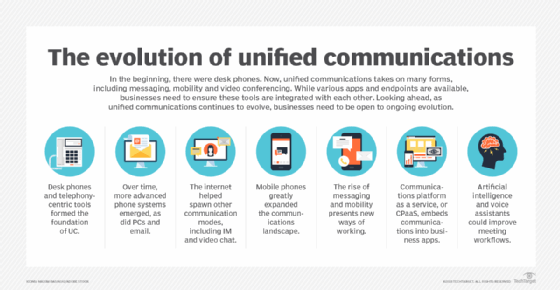How AI is transforming unified communications
AI in unified communications can take employee collaboration and productivity to the next level. But AI does carry risks that enterprises must first address to maximize adoption.
AI is now the dominant trend in technology and is being widely applied both in the business and consumer worlds. When technology becomes this ubiquitous -- and so quickly -- we all must understand how it will affect our lives.
AI, however, is complex, and rather than trying to understand how it works, IT decision-makers need to focus on use cases and where AI brings value.
Understanding AI in unified communications
For enterprises, unified communications (UC) is one of those leading AI use cases. The focus needs to be on AI technology helping UC do what it does best. From the outset, UC has always been about increased productivity and collaborative work. Coming out of the COVID-19 pandemic, it must also now support remote and hybrid work.
Until recently, UC has been effectively addressing these needs without AI. But, when considering AI, IT decision-makers are starting to see next-level possibilities for UC across all work environments, not just in the office.
This article is part of
Ultimate guide on enterprise unified communications strategy
To understand why the opportunity with AI and UC is so promising, two drivers need to be recognized. First is the widespread adoption of UC, which accelerated during the pandemic. Today, businesses of all sizes are deploying some form of UC.
Secondly, employees -- end users -- are more comfortable using UC, so adoption should occur quickly when introducing AI-based applications. It won't take long for IT leaders to see which AI applications are working best, both in terms of productivity and employee experience.

AI applications for UC
With AI evolving so quickly, new business communications tools keep coming. IT leaders need to view this as a continuum of innovation. UC will always be a work in progress, and AI is just another layer for its ongoing evolution. The first wave of AI innovation for UC, which includes applications like automated transcription, real-time translation, noise suppression, meeting summaries and biometrics, has now become table stakes for providers.
These applications continue to provide value for collaborative work, but IT leaders now must look ahead to the next wave with AI. Initial AI applications were mostly about automating tasks, such as scheduling and note taking, and that speaks to how automation is often the driver for building a business case.
AI is now able to take things a step further by not just automating tasks, but also automating workflows. For example, automated transcription has value for making a task better, but now, AI can act on the transcription's content by deploying virtual assistants to manage follow-up activity, such as scheduling a new meeting or providing customized meeting summaries for those who didn't attend the meeting.
Generative AI, where chatbots can generate communication on your behalf, is the latest AI breakthrough, freeing up time for more in-person interaction. With minimal training, these chatbots can compose emails, letters and reports that are not just good proxies for humans doing the work, but are good enough to generate outputs that reflect personal communication styles. As these capabilities mature, it won't be long until virtual assistants can manage many everyday activities.
AI challenges with UC
New technologies always come with risk. Not surprisingly, AI's disruptive potential comes with great risk and many challenges, including the following:
- Accuracy. When using voice assistants to execute instructions, there must be clear understanding of the task to achieve the desired outcome. Otherwise, workers have to do the work all over again themselves, defeating the purpose of using AI for increased productivity.
- Complexity. To get beyond basic tasks related to UC, AI applications must understand the work environment at a deeper level by understanding context, intent and nuance. This goes well beyond basic speech recognition, where the sole objective is to accurately capture what was said in text form. These applications of AI only work as well as the instructions provided by humans, so employees need to learn how to interact with AI to get the desired outcome.
- Bias. A nontechnical challenge comes from learning to trust AI applications. One example is detecting bias that can come from any number of sources. Given how diverse today's workforce is, collaborative work can become problematic if the AI applications use inappropriate references or incorrect assumptions. This can quickly make for uncomfortable work environments and a difficult employee experience.
- Trust. Perhaps the biggest AI challenge is being able to trust the outputs, especially when coming from generative AI. Often, the sources are not cited, making it difficult to know what the output is based on, what information was considered but not used or how complete the underlying analysis is.
The shortcomings are familiar to anyone who has used generative AI. Accuracy aside, there can be bigger concerns, such as plagiarism, copyright violations, or fake or fraudulent sources. As such, when using AI to do collaborative work, everyone on the team needs to understand these challenges. Otherwise, someone will be too trusting with AI, and the fallout could go well beyond the team.
The future of AI with UC
At the moment, the future outlook is a bit mixed, as the risks associated with AI are coming under growing scrutiny. Ultimately, that will lead to better guardrails in the form of regulation and best practices among enterprises. AI has evolved faster than our ability to responsibly use it, so this scrutiny will help make everyone more comfortable that "AI for good" will prevail.
In terms of UC, we will continue seeing more applications, especially as the performance of AI keeps improving:
- Meeting engagement. UC services will further use AI to make meetings more engaging as remote work becomes integral for collaborative work. Prime examples include AI-driven video applications that make everyone feel like they're in the room and ensure participants are visually represented equally, regardless of location or where they are in the meeting space.
- Mobile apps. Another aspect of remote work is the reliance of mobile devices for collaborative work. As 5G-enabled smartphones become more common, they'll be able to support more AI applications, helping them have an employee experience that's totally comparable to the desktop.
- Immersive spaces for collaboration. Virtual and augmented reality applications have yet to catch on in the workplace, but Microsoft, Meta and Apple, among others, are touting metaverse-style workspaces. Today's employee experience is going to cater ever more to digital natives, for whom this will feel quite comfortable.
As the demographic of digital natives comes to personify the modern workforce, AI-driven UC will become a mix of physical and virtual work environments, where everyone will have virtual assistants. That may not be the reality now, but it's a good indication of how AI is changing UC, along with the essence of collaborative work.
Jon Arnold is principal of J Arnold & Associates, an independent analyst providing thought leadership and go-to-market counsel with a focus on the business-level effect of communications technology on digital transformation.







